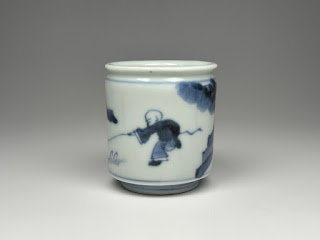童子牛追図 のぞき猪口 Cow and Boy Nozoki-type Cup
少年が牛に縄をゆわえて引っ張る図は、古伊万里の絵柄としてはそれなりに例があり、初期伊万里にもみられる(「古伊万里蕎麦猪口・酒器1000」講談社、2001年)というが、のぞき猪口の絵柄としてはかなり珍しいだろう。絵柄も珍しいが、もっと珍しいのは口の部分の細工だ。わたしも20年近く古伊万里ののぞき猪口に注目してきたが、こういった「くびれ」のあるのぞきは1000個に1個かそれ以下の出現頻度だとおもう。
There have been known a few examples of Imari porcelains that depict a boy pulling a cow with a rope, but I think a nozoki-type small cup with this drawing is really rare. It is much rarer to see a wavy "neck" at the top part. Frequency of appearance of that will be one to a thousand or less from my 20-year experience.
古伊万里ののぞき猪口は、酢、味噌、醤油、煎り酒など刺身のつけだれ(あるいはかけ汁)をいれるための器で、あらたまった会席料理の中で刺身皿に添えられたものだ。江戸時代は、鮮魚の流通はいまほど発達していなかったし、酢や醤油もまだ貴重だったから、こういった「ごちそう」の席を華やかにするような、調味料専用の器が尊ばれたのである。
以下はほとんど根拠に乏しい私見ではあるが、17世紀後半から18世紀初頭にみられるのぞき猪口の前駆的なタイプには、長猪口や末広がりのものなど、形状にバリエーションがある。その後、18世紀前期〜中頃になると、円筒形のいわゆる「のぞき猪口」が形式として確立する。酒や酢、醤油等が大量生産されるにともなって「刺身皿にはのぞき猪口」という取り合わせがある種のお約束として一般に普及していったのだろう。
それから50年くらいたって、18世紀末から19世紀になると、末広がりの形だったり、チューリップ形だったり、いろいろな形状の猪口が出現する。これは江戸や大坂の富裕層の食文化が一般庶民や地方にも波及して陳腐化したことで、より新奇な形態を求める需要があったことに対応するものだろう。ここで紹介した「くびれ」のある猪口も、そうした流行の産物かもしれない。
以前の記事にも書いたが、江戸の高級料亭「八百善」の四代目オーナーだった栗山善四郎が文政年間に著した「料理通」には、刺身皿に添えるのぞき猪口がイラスト入りで紹介されている(皿や椀など料理を盛る器本体の絵は描かれていない)。その15種ほどののぞき猪口のうち、口にくびれがあるものが3種もみられる。オーソドックスな円筒形のタイプの猪口はむしろ少ない(下の図を参照)。当時江戸の流行の最先端をゆく料理屋だった八百善では、メニューはもちろんのこと、調味料入れである猪口も、そんじょそこらのものとは違うものをつかっていた、ということを暗示している。
Nozoki-type Imari cups were used to serve various sashimi sauces made from vinegar, miso paste, soy sauce, and cooked sake in a formal dinner in the Edo period, when not only fresh fish but also vinegar and soy sauce were precious and a special cup for sashimi sauce was valued.
In my opinion that lacks strong evidences, there were various types of small Imari cups (choko or choku in Japanese; see examples like this or this) in the late 17th century to the beginning of the 18th century. And then, a standard nozoki that is almost cylindrical in shape got to be widely used as an accessory of a sashimi dish, as sake, vinegar, and soy sauce had been widely produced. In the end of the 18th century or later, various small cups emerged again probably because the use of nozoki became a little old-fashioned. I guess the above cow-and-boy cup would be made in that era as a variant of nozoki.
It is interesting that, in a book written by the fourth owner of "Yaozen" that was a famous restaurant in Tokyo (Edo) in the early 19th century, not only various sashimi menu and recommended sauces but also illustration of nozoki and similar small cups were shown. Of particular interest is that standard nozoki was rare, and three cups with wavy necks can be found. As Yaozen was one of the most popular restaurant in Tokyo, it might use novel tablewares that were distinct from others.





